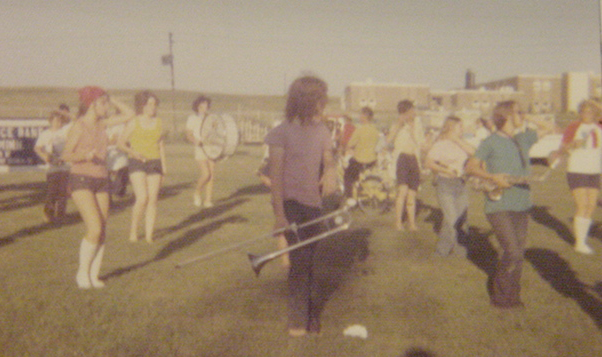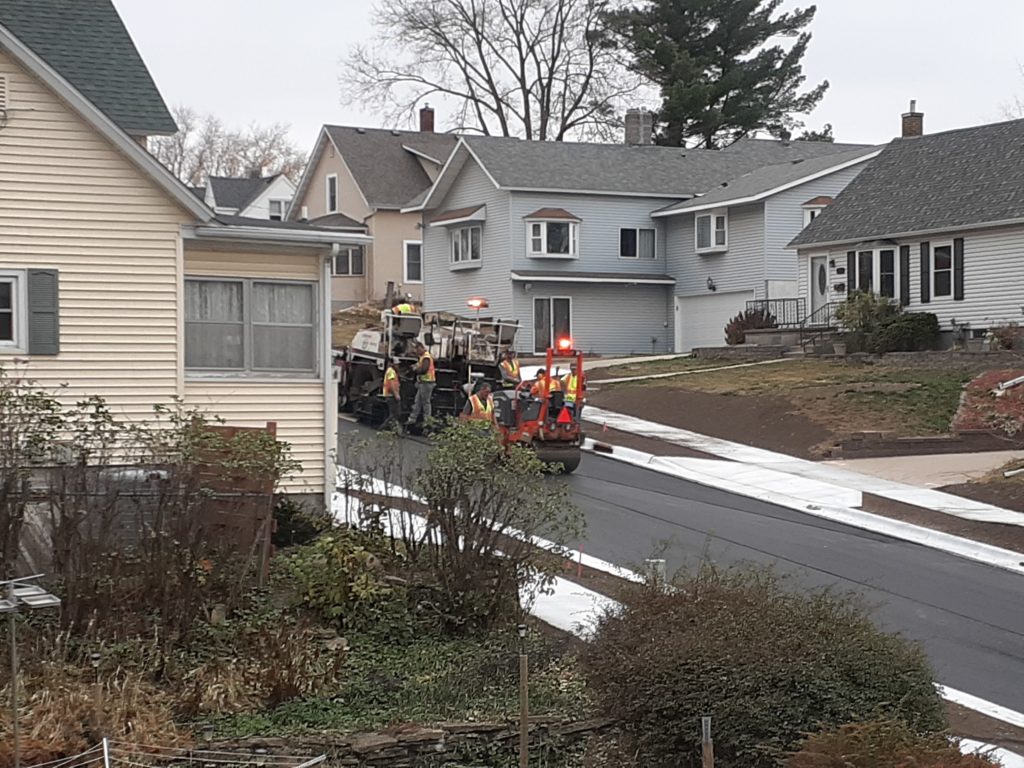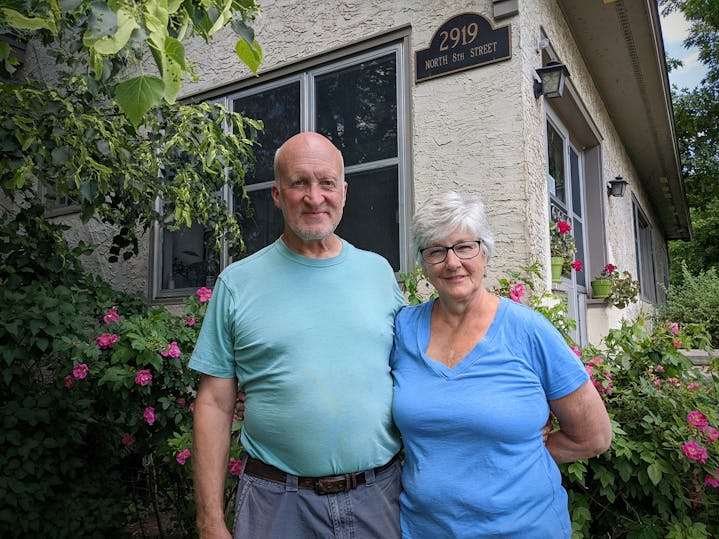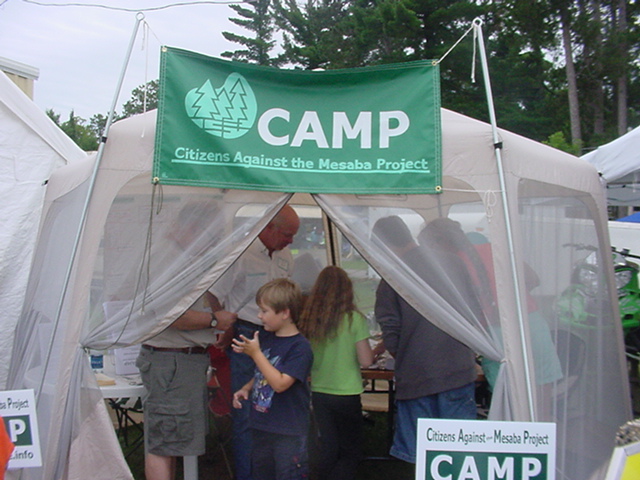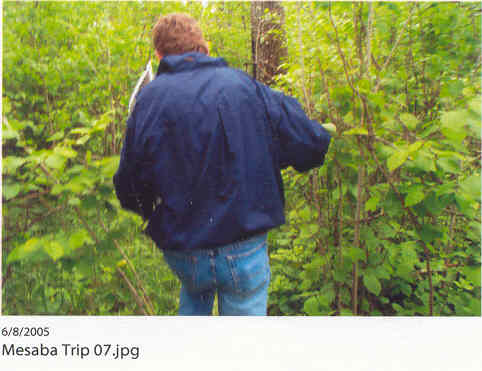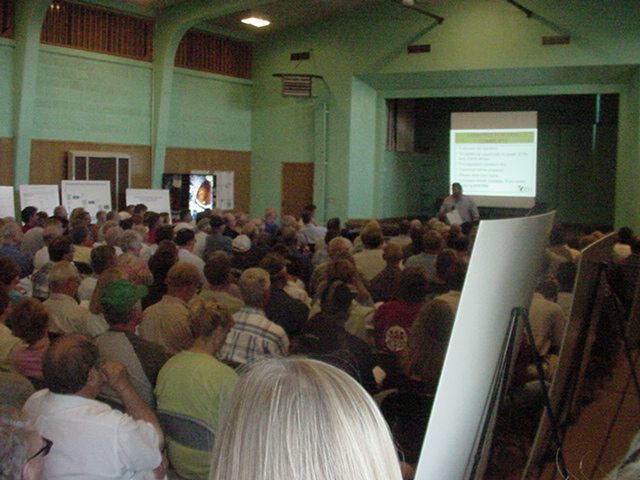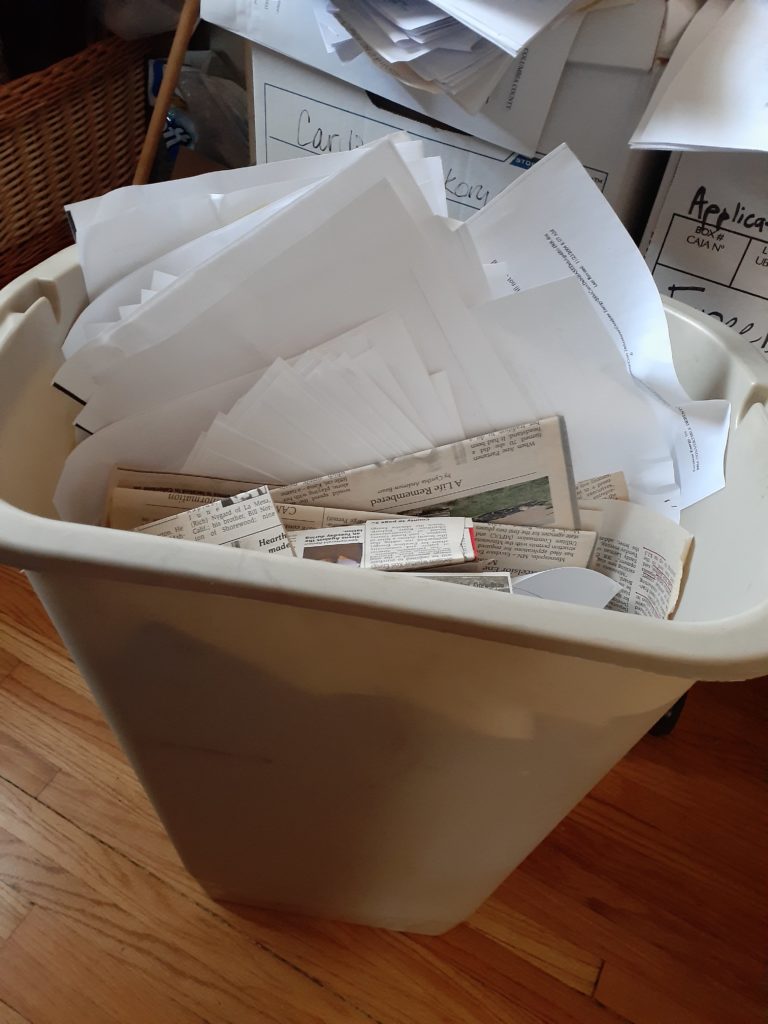U of M women couldn’t march?!?!
October 25th, 2022
50 years ago, women were admitted into University of Minnesota marching band, but not without a fight
Here’s the schedule of activities for Friday and Saturday, October 29-29, 2022:
Trailblazers: A Celebration of Women in the “Pride of Minnesota”
It’s disconcerting that this is a celebration, but yes, that the program includes “It’s About Damn Time” does help (and synchronized swimming?!?!).
To think that for decades before this, just a couple blocks away, St. Lawrence Band was marching all over the state, and even to Washington D.C. and New York’s St. Patrick’s Day Parade. Good grief, why, U of M, did this take so long?
City infrastructure assessments – how and why?
October 24th, 2022
UPDATE: After commenting at last night’s meeting, and the missive below, Council Pres. Becky Norton requested staff to provide update to Council of 1) how city assessment process works; and 2) how other cities handle assessments. Now, to make sure that this is a public process and affected folks are asked to weigh in.
Just sent the Red Wing Mayor and City Council another missive about public infrastructure assessments by the City (spurred by the STrib article today, below):
All –
The good news is that Sturtevant’s first layer of asphalt is down! YEAAA! Seeding is done, and we’ll see what happens next spring. They also poured a little retaining wall by our day lilies at the corner:
No question that this Sturtevant redo was LONG overdue. Infrastructure improvements are good for the city, it’s INVESTMENT in community, job creation, and like the West Main project and the bridge, the levee upgrade for more of the big boats, and bike trails, it’s all economic development which we sorely need, investments that make it easier to get around and more attractive for business.
Assessments are another matter… Yes, another issue for the Mayor and City Council (Thanks to Dean, and Becky too, and Ryan Illa, for responding on the Sturtevant and West U.S. mail non-delivery issue. No response from our new W-2 Councilor Kliewer, perhaps isn’t getting his mail either?. We still have no mail delivery, despite sidewalks done for a week now):
City streets and sidewalks and sewer and water are used by everyone, it’s public infrastructure. Recognizing that street assessments are only an apportioned percentage of the full cost, it’s still too much for individual property owners. It’s an inherently unfair, inequitable way of covering these costs for public infrastructure improvements.
At the outset, I recognize that the assessment reflects an apportioned cost, based on property footage (not market value of property as it is in some other jurisdictions), and that cost that is apportioned to property owners is not the full cost of the project, but a percentage of the project cost (25%? Apologies, Marshall, I’ve forgotten that %!). I also recognize that there is funding from other sources; for the Great West Wall, there was federal funding, and for Sturtevant I’d guess there’s state funding, and it’s my belief that the LGA and other state funding to cities has been at least partially restored. What percentages of this Sturtevant project are paid by state or other sources? Whatever the % apportioned and assessed, I’m not requesting that the % assessed to individual property owners be lowered.
My take is that assessments for public infrastructure, because it is PUBLIC infrastructure, should be spread across the entire base of property owners in the City, residential, commercial, and industrial, and yes, even non-profit-owned property.
My request is that the city rethink how it assesses for public infrastructure improvements, and that this be considered in a public way, soliciting comments from landowners (we have a project list, so it’d be easy to contact those affected by this Sturtevant project). Public engagement, eh?
How much of an assessment for the Sturtevant project? For example, our assessment for Sturtevant, coming on the heels of the Great West Wall assessment, is expected to be $5k+ (and an additional $5,500 for new sewer and water connecting to the city’s at the sidewalk). That’s $11,000, and that’s a lot for any of us along Sturtevant. That $11k is twice the cost of our van and car! I have the advantage of being able to work until I drop and we have nominal savings to cover the cost. I don’t think that most of my neighbors have this privilege. Financing that cost is no solution. The City should not be in the business of charging interest on assessments that are inequitable from the get-go. (And that’s another issue… The interest rates are beyond market rate, and although it’s been lowered, this is something the City considers annually, and this needs to be more public, with notice to upcoming landowners who would be charged those rates on assessments. The City knows who these landowners are.)
How did people along West cover that cost? How will the folks along Sturtevant pay for it? Can you cough up $5,000 plus for an assessment and $5,000 plus for private connections? If you can, recognize that you are privileged. The fundamental issue here is one of equity — should individual property owners be required to pay for public infrastructure adjacent to their property? Why shouldn’t payment for public infrastructure be paid for by the public, the apportioned amount apportioned more broadly to reduce the individual impact? Though you may not be hearing from others, I’m not the only one struggling here, but I’m the professional advocate on the street, the one used to speaking up. Let it be known that this is a stretch for the working families on Sturtevant for whom the assessment constitutes one or more month’s gross income. This is a major financial burden for those of us along the street.
Again, my request is that the city rethink how it assesses for public infrastructure improvements, and that this be considered in a public way, soliciting comments from landowners.
Thanks for your consideration.
Carol
+++++++++++++++++++++++++++++++++++++++++++++++++++++++++++++
Minnesota street projects often are funded by hefty assessments. But is that fair or legal?
St. Cloud grapples with an issue that other cities have been addressing.
By Jenny Berg Star Tribune October 23, 2022 — 5:00pm
Jenny Berg, Star Tribune Kevin and Julianna Carpenter sued the city of St. Cloud after being assessed nearly $14,000 for road improvements near their home. After the city appraised the house, it lowered the assessment to about $4,000.
ST. CLOUD — Mary Hall got an unexpected $6,300 bill from the city three years ago. It was her share of the neighborhood project to resurface the road and replace underground utilities.
Hall thought the city was charging too much based on what her neighbor told her about state law: that a city can’t assess someone for more than their property value increases due to project improvements. But her husband had just died and she didn’t have the heart to fight City Hall.
Meanwhile, Hall’s neighbors Kevin and Julianna Carpenter sued the city in district court, and the city ultimately lowered the Carpenters’ $14,000 bill to $4,000. So the Carpenters — who live in a historic $330,000 house — paid less than the widow in her $100,000 house for the same road project.
“How does the city possibly think that’s fair?” asked Kevin Carpenter, a retired lawyer who is trying to get the city — or state — to change how it assesses property owners. Carpenter has spent hundreds of hours tackling the issue with city staff and through the state court system.
Cities around the state routinely charge property owners for improvements to roads and sidewalks. But in the past few years, a number of cities — including Duluth, Rochester, Edina and Northfield — have changed the way they pay for road projects in an effort to be more equitable and stay within the law.
Despite the state law, many cities do not consider market value at the front-end of a project. Instead, some cities, such as St. Cloud, assess property owners based on how many feet of the property touches the street being improved. Minnesota case law has determined this so-called “front footage” method is valid because it is a fair approximation of the market value increase.
Carpenter calls the policy regressive because it doesn’t take into account a homeowner’s income or ability to pay.
But St. Cloud City Administrator Matt Staehling argues special assessments are an important funding source that allow the city to obtain bonds to finance the street improvement projects.
What other cities are doing
“It’s an issue people care about. It’s hitting their pocketbooks,” said Tyler Niemeyer, assistant city engineer for Rochester, where a task force recently spent more than a year drawing up a new assessment policy. Now simple road resurfacing projects are funded through a tax levy instead of assessments. And larger projects proportion the cost based on people’s property values, resulting in assessments that likely will be lower than using the front footage method, Niemeyer said.
In Duluth, the city has entirely moved away from assessments for road projects, instead using proceeds from a sales tax that voters approved in 2017.
“We haven’t given up the ability to assess. We’re choosing not to at this time,” said City Engineer Cindy Voigt, who added it’s easier to manage the projects when residents “know they don’t have to pay for it on top of the dust, the dirt and the inconvenience.”
Northfield charges a gas and electric franchise fee that residents pay on their utility bill, which helps spread out the cost. An Edina task force spent eight months crafting a policy that transitions from funding road projects with assessments to funding projects with property taxes over about two decades. The Edina City Council approved the policy in July 2021.
“So instead of just the neighborhood paying for their streets, the entire city is paying for city streets,” said Chad Millner, engineering director for Edina.
Millner said the long transition is to placate residents upset after paying recent assessments. Their logic was, “I had to pay the fee so everyone else should, too,” Millner said. “We never solved the fairness problem.”
Burden is on property owners
Another complicating factor is that the onus is on residents to prove the assessment is greater than the increase to their property value.
So homeowners have to use time and resources to contest the assessment with the city and file a lawsuit in district court, which costs about $300.
“I don’t think the burden should be on the resident to know the back-channel law and have to fight it,” said Jason Theisen, a St. Cloud resident who fought his $16,500 assessment for a 2018 road project. “I think [the city] should just be following what the law is.”
Kevin Carpenter helped Jason and Kathryn Theisen filed an appeal in district court. The city then obtained an appraisal of their property and reduced their assessment to $5,000.
“In our opinion, the work needed to be done. Infrastructure is important. We had no issue paying something,” Jason Theisen said. “Just when we got the sticker shock of the initial amount, it was like, holy moly.”
After hearing Carpenter’s complaints about his assessment, longtime Council Member George Hontos asked city staff and other council members to consider simplifying the process for residents to re-examine their assessments before needing to go to court. But it never materialized.
“I just feel uncomfortable thinking [suing the city is] the only recourse,” Hontos said. “It just doesn’t seem to be user friendly or considerate of the residents.”
(rest of article here: https://www.startribune.com/minnesota-street-projects-often-are-funded-by-hefty-assessments-but-is-that-fair-or-legal/600218369/)
It was 20 years ago today…
October 22nd, 2022
EXCELSIOR ENERGY’S MESABA PROJECT
PARTIAL DOCUMENT REPOSITORY
Well, a bit more than 20 years ago… January 15, 2002, just after the start of the legislative session, I was at an energy committee meeting, Senate? House? I think Senate was first, then heard again at House, and the following year they got their legislation through as a part of the 2003 Prairie Island bill.
- The Excelsior Energy link I’m using is compliments of waybackmachine. Note that now, if you plug in “excelsiorenergy.com” it becomes “excelsiorcapital.com (Excelsior Energy Capital).” essentially at a marina at 21960 Minnetonka Blvd.! Related?
Anyway, there was a presentation back in 2002 about the greatest thing since sliced bread (NOT!), a coal gasification project proposed for “somewhere” on the Range. Here’s what they presented:
Note the parts about “brownfield” and “existing infrastructure.” LIES, it’s that simple. Here’s what their site looked like, this was at the DOE and locals site visit in 2005:
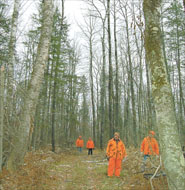
Starting in 2005, I was representing “mncoalgasplant,” landowners and residents near the proposed project, joined in tandem by Citizens Against the Mesaba Project (CAMP) (site circa 2013 with live links, thanks waybackmachine!). We had such active folks, every hearing was PACKED, and eventually the project faded, never formally declared dead, but piece by piece, it went away.
HOWEVER, Excelsior Energy did manage to get an save passed by the legislature for a natural gas plant:
Week before last, I picked up files from a cohort who shall remain unnamed, and am scanning in boxes of files, to post here, and recycle hard copies for biomass (UGH, but that’s what Red Wing does. Thanks, Xcel Energy!). I’ll be posting them, some interesting stuff if you’re into energy and political and capital intrigue, some purely inside baseball that no one will care about.
MONEY TRACKING – Spreadsheets and invoices to IRRB for reimbursement
Various Contractor Invoices (some redacted)
What a pain in the patoot that was — TWO ENTIRE WASTEBASKET OF SCANNING!
Annual PPSA Hearing – November 9!
October 22nd, 2022
Just got notice of the Minnesota Public Utilities Commission‘s Power Plant Siting Act annual hearing:
This happens every year, and it’s important to spread the word around. One change that is very good is that the Commission is doing a good job of serving notice of the hearing — there are ~ 128 pages of recipients of this notice! GOOD! Love the interwebs, makes it so easy to let people know what’s happening.
The “Power Plant” aspect is very broad, this includes not just “power plants,” but transmission lines, wind projects, and solar too. This is the opportunity to tell the Public Utilities Commission, and the state generally, what works and what doesn’t work about the procedures for siting electric utility infrastructure, ideally based on your experience.
One positive aspect of COVID is that hearings are now held in “hybrid” format, both in person and online via Webex:
It is best if using Webex (http://mn.gov/puc/about-us/calendar/ and click on “November 9, 2022” to get to “webcast”) to have video on your computer and to use the phone for audio, whether listening or making comments — that’s the best way to avoid feedback (using headphones helps too). The webcast link usually goes live 10 minutes or so before the hearing starts.
What to comment about? If you’ve had experience with a Public Utilities Commission siting docket, if there were issues that made it difficult to participate, things needing clarification, rules and/or procedures that need changing, this is a way to bring it to the Commission’s attention. Over the 27 years that I’ve been dealing with utility siting issues, oh, the horror stories I can and do tell. The system needs work, and siting infrastructure is a constantly evolving process, sometimes very good changes are made, and sometimes, no matter how much we petition (formally and informally), challenge, cajole, demand, they just won’t take responsibility, won’t do their jobs, and won’t even promulgate necessary rules.
A main point of holding this hearing, as above, is hearing from “the public.”
In addition to the public participation issues exposed in this report (about which not much, not enough, has been done), a few things that I’ll be bringing up, orally or in writing:
- The Office of Legislative Auditor investigated the Public Utilities Commission‘s practices, and this report had recommendations, most of which have not been addressed:
OLA-Report_PUC Public Participation 2020
- The Public Utilities Commission has not, in the decades I’ve been participating in the PPSA Annual Hearing, EVER brought up the PPSA for discussion and ACTION on issues raised.
- Wind siting “guidelines” were adopted via Commerce-EERA without public notice or opportunity for input: Large Wind Application Guide.2
- Notice has not been provided to landowners on transmission line routes where “alternate” routes are proposed, and sometimes landowners have not discovered their land may be affected until the public hearing, very late in the process.
- Power Plant Siting Act rule revisions, due after the 2005 Power Plant Siting Act legislative changes, have not been promulgated, despite a years long process, NINE YEARS, many committee meetings, and a lot of work by a lot of people. The Public Utilities Commission just dropped it… no action… sigh… Minn. R. ch 7849 & 7850 Rulemaking? DEAD!
- Despite 2 rulemaking petitions to the Public Utilities Commission, there are no wind siting rules! The Commission refuses to promulgate wind siting rules, instead using Small Wind Standards:
There’s no end to the issues to raise.
In addition to the public hearing, comments may be submitted in writing:
Get to it! Register your experience with the Public Utilities Commission, and let them know what needs work.
Too diverse for Sviggum!
October 17th, 2022
UPDATED UPDATE: Sviggum voids apology with additional comments:
University of Minnesota regent resists calls to resign
It’s “Alpha News” of course, but here’s part of what he’s saying:
… and…
UPDATE: Sviggum “apologizes.” The “apology” and full STrib article below.
Steve Sviggum, now “representing” District 2 on University of Minnesota Board of Regents, shows his true colors:
He was claiming to have received 2 contacts from “friends” whose children wouldn’t go to Morris because it’s “too diverse, that they wouldn’t feel comfortable there.” Earth to Sviggum, this is the opportunity, particularly as a face of the University of Minnesota, and supposedly representing the 2nd District, to suggest to your friends that maybe, just maybe, this is exactly the experience and environment that your “friends’ children” need in the 21st century! Maybe it’s the perfect opportunity to suggest to your “friends” that they too need to get out into the world and out of their white bubble. And maybe it’s time for YOU to get out of your bubble. For sure it’s time for you to be off the University Board of Regents.
What’s really interesting is the composition of the student body now. Per the STrib (University of Minnesota Regents Vice Chair Steve Sviggum asks if Morris campus is ‘too diverse’):
“32% Native American – and is that what’s so objectionable? Or is it those likely more visible 3% black students? 4% Hispanic, which should be higher given the increasing Hispanic population in the area? Or is it that someone just saw those oh-so-scary numbers and ran back to their bubble?
Click HERE for the “Contact” page for the University’s Board of Regents. You know what to do.
Here’s a response from U of M Morris’ Student Association President:
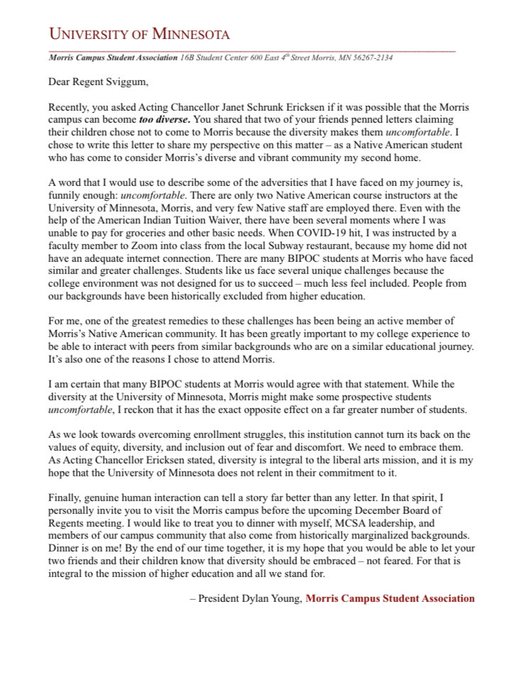
And this from Chair of Regents:
FYI, Regents are elected by the Legislature — see this from House Research:
Election of Regents
And it gets interesting, because his term does end in 2023, and he’s “representing” CD2, and much of CD2 (my part, in Red Wing too) is becoming CD1, not exactly something I’m excited about. Anyway, I’d think that CD2 residents would be particularly upset about his comments.
++++++++++++++++++++++++++++++
UPDATE: The “apology” here:
Last week, during University of Minnesota Morris Interim Chancellor Erickson’s presentation on MPact 2025 enrollment goals at Morris, I posed a question regarding the diversity of the student body and whether that diversity was—in any way—linked to the recent enrollment challenges.
Let me unequivocally apologize for my questions, and especially for the unintended hurt my questions may have caused. They were not intended to cause harm, but my intent does not matter. For those whom I have harmed or offended, and for all of those associated with our great university, I am truly sorry. I have only respect and admiration for any individual who seeks to better themselves through higher education, whether at Morris or at any of our wonderful campuses. Minnesota benefits from our many amazing students from all walks of life who make incredible contributions to our community, and their work strengthens the great state of Minnesota. I hope that all of our graduates elect to stay in Minnesota after graduation and work, every day, for the betterment of our state.
My intent – recognizing that my words matter – was to foster discussion around the consistently declining enrollment at Morris, which is not a one-year trend or even a concern that has emerged out of the COVID pandemic. Rather, student enrollment has been declining for years (down 50% from its peak) and the future of this great campus depends on finding solutions to reverse that trend.
I have been blessed throughout my life as a farmer to work with a diversity of people across our state and our nation from all backgrounds. As a layperson in my church, I have shared the joys and heartbreaks of so many of my fellow parishioners. And as a proud Regent, I have been given the incredible opportunity to help our institution, our president, and our students, staff, and faculty who set a very high bar for the rest of us.
Again, I offer my sincerest apologies. I clearly have more to learn to better understand the strength that diversity brings to our institution, and I look forward to taking those who have reached out to me up on their offers to meet and to hear their perspectives and learn from them. I am willing to learn and I must do better—and I will.”
STrib article:
Sviggum ‘unequivocally’ apologizes for asking whether Morris campus is ‘too diverse’
The former Minnesota House Speaker issued a written statement amid calls for his resignation.
By Rochelle Olson Star Tribune October 19, 2022 — 9:14am
Glen Stubbe, Star Tribune fileUniversity of Minnesota Regents Vice Chair Steve Sviggum said he is “truly sorry” to those whom he harmed or offended.
The vice chairman of the board that oversees the University of Minnesota system apologized “unequivocally” for asking whether enrollment at the Morris campus was “too diverse.”
In a five-paragraph statement issued through the public relations office on the Twin Cities campus late Tuesday, Steve Sviggum said he’s willing to learn and must do better.
Sviggum wrote that his intent was to encourage discussion about the ongoing decline in enrollment at the Morris campus, which is down 50% from its peak. “The future of this great campus depends on finding solutions to reverse that trend,” he wrote.
At a regents meeting last week, Sviggum asked acting Morris Chancellor Janet Schrunk Ericksen whether diversity was linked to declining enrollment.
“I’ve received a couple letters, two actually, from friends whose children are not going to go to Morris because it is too diverse,” Sviggum said at the meeting. “They just didn’t feel comfortable there.”
Ericksen responded that minority students on the campus often feel isolated and that from their perspective, no, the campus would not be too diverse. The question sparked backlash and calls for his resignation from the volunteer position. A Native American student leader at the Morris campus invited Sviggum for a meal and circulated a petition that received 200 signatures.
Regents Chair Ken Powell released a statement calling diversity a “strength.” The Teamsters Local 320, which represents 1,500 workers across five campuses, called his comments racist and part of a pattern.
Former regent Michael Hsu, who said Monday that Sviggum’s time had passed and he need to resign, was dismissive of the attempted apology. “He should be gone already,” Hsu said.
In his statement, Sviggum said he is “truly sorry” to those whom he harmed or offended. “Let me unequivocally apologize for my questions, and especially for the unintended hurt my questions may have caused,” he wrote. “They were not intended to cause harm, but my intent does not matter.”
He said he respects and admires everyone who seeks to better themselves through higher education. “Minnesota benefits from our many amazing students from all walks of life who make incredible contributions to our community, and their work strengthens the great state of Minnesota,” he wrote.
The former GOP House speaker and state administrator from Kenyon said he’s been “blessed” to work as a farmer with a diversity of people. He talked about sharing joy and heartbreak with parishioners as a layperson at his church.
“I clearly have more to learn to better understand the strength that diversity brings to our institution, and I look forward to taking those who have reached out to me up on their offers to meet and to hear their perspectives and learn from them,” he wrote.
In numerous media interviews after his comment became public, Sviggum initially was unapologetic. He said he was posing a question, not making a statement.
Currently, Morris has 1,068 students. Of those, 54% are white and 32% are Native American. Overall, 41% are Black, Indigenous and people of color.
The goal for the Morris campus is 1,700 students, a target set in 2019 before the pandemic. The campus hasn’t had that many students in at least five years, and colleges across the country are struggling with declining enrollment.
In an interview Monday, Sviggum noted that overall enrollment at Morris had decreased by 40% as the enrollment of Black, Indigenous and people of color had increased to nearly 45%. “It’s fair to ask the question: Is there a relationship?” Sviggum said.
Dylan Young, president of the Morris Campus Student Association and a Native American student from Parmelee, S.D., has publicly commented in interviews and on social media. He said he received 200 signatures on a a letter to Sviggum on social media.
Sviggum’s tenure on the board will end in 2023 when the Legislature selects new regents.
From 1979 to 2007, Sviggum served in the state House as a Republican from Kenyon. He became the speaker after the 1998 election when Republicans took control of the House; he lost the top job after the 2006 election.


